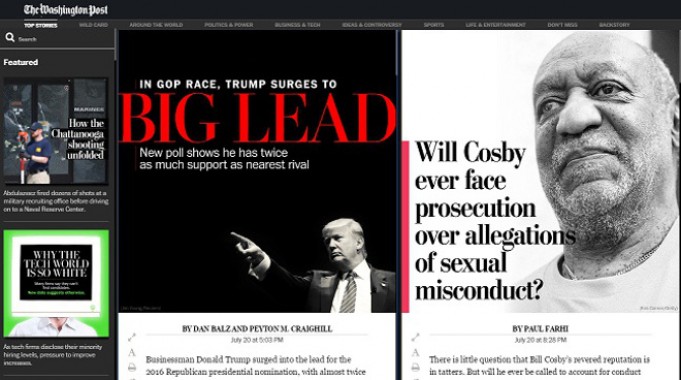The Washington Post crucible
OUT OF PRINT
Binoo K John
In the future of the Washington Post as a newspaper lie the survival stories of many dailies around the world. The reason is that newspapers can replicate the strategy devised by Washington Post owner, Amazon’s Jeff Bezos, to save the paper. Since it was unveiled, his web and digital strategy have resulted in 51 million unique visitors to the paper’s site in April .
The Post website now comes in a magazine format with one story per page. Design-wise, Bezos is subverting the very nature of a newspaper. It opens out like a book and is easy to navigate, making it extremely reader friendly. The pages open forward and back. The Post app, on the other hand, has a vertical format and you need to scroll up and down. The app also has a vertical search which throws up what you are specifically targeting.
The best news for journalists is that a 100 new employees have been hired in the newsroom, according to reports. And no culling so far.
The website is free but Bezos is not one to give freebies. So astute is he about revenue that this month he announced the Amazon strategy of paying authors not the royalty or commission on the downloaded book but only for the number of pages read by the customer.
Carrying this logic forward, will the Post paywall (six months on) website charge you only for the stories you have read? Kindle Fire also comes bundled with the app and may also go free to Amazon Prime subscribers. If you have a captive audience with you - through Kindle - there is little reason to worry about readership.
But revenue is a different ball game. At the Post, Bezos has never asked for profit statements since his strategy is to first scale up and then collect the cash. What is of interest is that the print version, despite its falling circulation, is still bringing in the advertising revenue.
All newspapers have apps and a web presence but few have got the number of hits that the Post has. It is due, of course, to the cult that has been built around Bezos and his genius. On him hinges the final answer to the question: do print newspapers have a future? The crucial question of whether the print edition is feeding the digital version or the other way round will be decided by the Post and Bezos. If Bezos, who paid $250 million for the brand, shuts down the Post’s print edition, then that will be the end of newspapers.
The crucial fact to note here is that 85 per cent of the people who use digital or mobile devices are looking for speed in getting their news and the rest opt for depth. A mix of long reads and short reports may be what is in store as Web 3.0 and Bezos’ strategy unfold.
* * * * *
A worrying trend in some leading newspapers is to run stories based on the reporter’s imagination, a phenomenon first started by entertainment supplements like the Delhi Times where cub reporters run stories about a filmy marriage or affair without any sourcing. The spiced-up heading will say that ‘A is marrying B’ and the first paragraph will source this news to “rumours” or the “Bollywood grapevine”.
How can rumours be reported as truth? The last paragraph will have a denial from the manager of A that anything of the sort is happening. What is the logic of running a headline saying exactly the opposite of what the story says?
This tendency has caught on. In the business section of the Times of India, I saw this headline - ‘E-Comm giants add IPL teams to shopping list” (TOI, July 17). But the story is far from definitive: “It is learnt that the country's most talked about e-commerce giants such as Amazon, Flipkart, Snapdeal and Paytm have expressed interest to pick up a franchise at a bargain in the lucrative yet corruption-hit cricket tournament.” Further, “Amazon India, Flipkart and Snapdeal did not reply to e-mailed questionnaires on the issue.” !!
Meanwhile, the Hero MotoCorp spokesman is quoted as saying they are not interested in the IPL, effectively contradicting the story and the headline. The Jindal group is quoted as saying they are waiting for the air to clear. A Paytm spokesman says they are watching the space which is no indication at all that they are going to buy a team which may be valued at around Rs 800 crore (though the valuation may decline due to the betting scandal). A level of cynicism should hover around the newsroom to prevent such misleading and contrived stories getting play, totally misleading the reader.
* * * * *
The standards of editorial supervision are declining drastically and surprisingly the biggest gaffes happen in big newspapers which have a huge number of subeditors staffing the newsroom. The Hindustan Times of July 14 published a boxed story with a picture (see scanned pic) headlined: “Longest tunnel waits for completion in Chennai”. To those like me who wondered how the longest underground tunnel could be built in a metro city like Chennai the answer was in the story itself. The longest tunnel was not in Chennai but in faraway Chenani, 90 km from Jammu and part of the Jammu-Srinagar highway. Even the caption of the picture says ‘Chennai’.

It is another indication of the increasingly lackadaisical attitude of subeditors, a fact that a senior editor at the paper lamented to me. The reason could be that the new generation subeditor is not interested in newspapering and is merely waiting for a chance to join TV.







